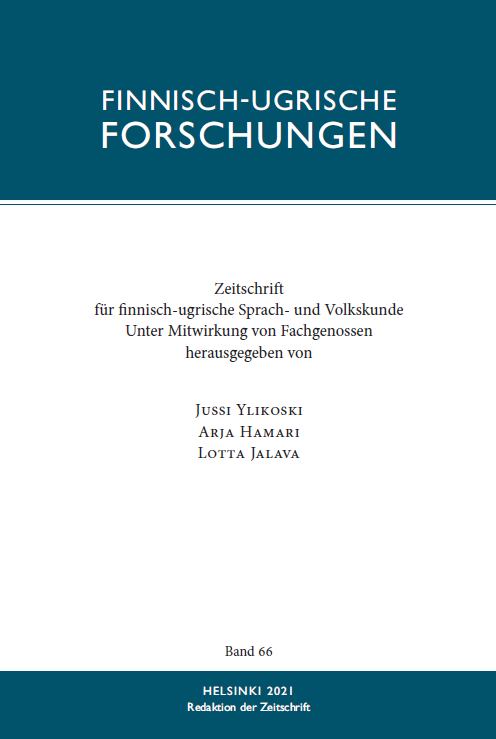Marking strategies of attributive possession in Selkup
A study of frequency and types of possession
DOI:
https://doi.org/10.33339/fuf.97373Keywords:
Selkup, Selkup dialects, attributive possession, possessive constructions, corpus studyAbstract
This paper deals with attributive possession in North, Central and South Selkup and focuses on a quantitative analysis of the frequency with which marking strategies are used in Selkup dialects. In Selkup, attributive possession can be head marked (with a possessive suffix), dependent marked (with genitive or adessive marking), and double marked (both combined), but close study shows that while dependent marking with genitive is most commonly used for lexical possessors, for non-lexical possessors the most common usage is head marking with a possessive suffix. The paper also illustrates the usage of different types of possession (e.g. inalienable/alienable) and shows that they are rarely treated differently with regard to their marking.
References
Bekker, Erika & Alitkina, Larisa & Bykonja, Valentina & Ilʹjašenko, Irina. 1995a. Morfologija selʹkupskogo jazyka. Južnye dialekty. Častʹ 1. Tomsk.
Bekker, Erika & Alitkina, Larisa & Bykonja, Valentina & Ilʹjašenko, Irina. 1995b. Morfologija selʹkupskogo jazyka. Južnye dialekty. Častʹ 2. Tomsk.
Budzisch, Josefina. 2015. Possession in Southern Selkup. Tomsk Journal of Linguistics and Anthropology 4(10). 45–50.
Budzisch, Josefina. 2017. On the non-possessive use of possessive suffixes in Central and Southern Selkup. Ural-Altaic Studies Scientific Journal 25(2). 58–66.
Budzisch, Josefina. 2018. Annotation Guidelines for the Selkup Corpus. https://corpora.uni-hamburg.de/hzsk/de/islandora/object/file:slc-1.0.0_Selkup_Language_Corpus_1.0.0_Guidelines/datastream/PDF/slc_guidelines.pdf
Budzisch, Josefina. 2021. Definitheit im Selkupischen (Studia uralo-altaica 55). Szeged: Finnisch-Ugrisches Institut.
Budzisch, Josefina & Harder, Anja & Wagner-Nagy, Beáta. 2019. Selkup Language Corpus (SLC). Archived in Hamburger Zentrum für Sprachkorpora. Version 1.0.0. Publication date 2019-02-08. http://hdl.handle.net/11022/0000-0007-D009-4.
Bykonja, Valentina & Kuznecova, Nadežda & Maksimova, Natalʹja. 2005. Selʹkupsko-russkij dialektnyj slovarʹ. Tomsk: Izdatelʹstvo Tomskogo gosudarstvennogo pedagogičeskogo universiteta.
Gluškov, Sergej & Bajdak, Aleksandra & Maksimova, Natalʹja. 2013. Dialekty selʹkupskogo jazyka. In Tučkova, Natalʹja & Gluškov, Sergej & Košeleva, Elena & Golovnëv, Andrej & Bajdak, Alexandra & Maksimova, Natalʹja (eds.), Selʹkupy. Očerki tradicionnoj kulʹtury i selʹkupskogo jazyka, 49–63. Tomsk: Izdatelʹstvo Tomskogo politechničeskogo universiteta.
Haiman, John. 1983. Iconic and economic motivation. Language 59. 781–819.
Haspelmath, Martin. 2017. Explaining alienability contrasts in adpossessive constructions: Predictability vs. iconicity. Zeitschrift für Sprachwissen-schaft 36(2). 193–231. https://doi.org/10.1515/zfs-2017-0009
Helimski, Eugen 1997. Die matorische Sprache (Studia uralo-altaica 41). Szeged: Finnisch-Ugrisches Institut.
Kim, Alexandra. 1985. Ausdrucksweisen der Possessivfügungen im Samo-jedischen. Linguistics 1. 50.
Kim-Maloney, Alexandra & Kovylin, Sergej. 2015. Taksonomija jazykovych sredstv vyraženija posessivnosti v selʹkupskom jazyke. Tomsk Journal of Linguistics and Anthropology 4(10). 36–44.
König, Ekkehard. 2001. Internal and external possessors. In Haspelmath, Martin & König, Ekkehard & Oesterreicher Wulf, & Raible, Wolfgang (eds.), Language typology and language universals (HSK 20.2), 970–978. Berlin: de Gruyter. https://doi.org/10.1515/9783110171549.2
Koptjevskaja-Tamm, Maria. 2001. Adnominal possession. In Haspelmath, Martin & König, Ekkehard & Oesterreicher Wulf, & Raible, Wolfgang (eds.), Language typology and language universals (HSK 20.2), 960–970. Berlin: de Gruyter. https://doi.org/10.1515/9783110171549.2
Koptjevskaja-Tamm, Maria. 2003. Possessive noun phrases in the languages of Europe. In Plank, Frans (ed.), Noun phrase structure in the languages of Europe, 621–722. Berlin: Mouton de Gruyter.
Körtvély, Erika. 2010. On the function of possessive suffixes in Tundra Nenets: Possession and semantic-pragmatic definiteness. Finnisch-Ugrische Mitteilungen 32/33. 321–343.
Künnap, Ago. 1999a. Enets (Languages of the World 186). München: Lin-com.
Künnap, Ago. 1999b. Kamass (Languages of the World 185). München: Lincom.
Kuper, Shimon. 1986. Mesto ketskogo dialekta v sisteme selʹkupskogo jazyka. In Nadeljaev, V. (ed.), Fonetika jazykov Sibiri i sopredelʹnych re-gionov, 103–106. Novosibirsk: Nauka.
Kuznecova, Ariadna & Helimski, Eugen & Gruškina, Elena. 1980. Očerki po selʹkupskom jazyku. Tazovskij dialekt. Tom 1. Moskva: Izdatelʹstvo Mos-kovskogo universiteta.
Nichols, Johanna. 1986. Head-marking and dependent-marking grammar. Language 62. 56–119.
Nichols, Johanna & Bickel, Balthasar. 2013. Locus of marking in possessive noun phrases. In Dryer, Matthew & Martin Haspelmath (eds.), The world atlas of language structures online. Leipzig: Max Planck Institute for Evo-lutionary Anthropology. (Available online at http://wals.info/chapter/24, accessed on 2021-01-13.)
Nikolaeva, Irina. 2014. A grammar of Tundra Nenets (Mouton Grammar Library 65). Berlin: De Gruyter. https://doi.org/10.1515/9783110320640
Orlova, Svetlana. 2018. Denominal l’-forms in Northern Selkup: syntax, morphology and semantics. Tomsk Journal of Linguistics and Anthropol-ogy 3(21). 31–40. https://doi.org/10.23951/2307-6119-2018-3-31-40
Ovsjannikova, Maria. 2020. Oblique and nominative nominal possessors in Forest Enets. Eesti ja soome-ugri keeleteaduse ajakiri / Journal of Estoni-an and Finno-Ugric Linguistics 11. 57–98. https://doi.org/10.12697/jeful.2020.11.2.03
Sebestyén, Irene. 1957. Die possessiven Fügungen im samojedischen und das Problem des uralischen Genitivs (I.). Acta Linguistica Academiae Sci-entiarum Hungaricae 7(1/2). 41–77.
Siegl, Florian. 2013. Materials on Forest Enets, an indigenous language of Northern Siberia (Memoires de la Société Finno-Ougrienne 267). Helsin-ki: Finno-Ugrian Society.
Tauli, Valter. 1966. Structural tendencies in Uralic languages (Uralic and Altaic series 17). The Hague: Mouton.
Vorobeva, Victoria & Novitskaya, Irina & Girfanova, Ksenia & Vesnin, Vitalij. 2017. Adnominal possessive constructions in Narym, Vasjugan and Middle-Ob dialects of Selkup. Linguistica Uralica 53. 54–64. https://doi.org/10.3176/lu.2017.1.05
Wagner-Nagy, Beáta. 2014. Possessive constructions in Nganasan. Tomsk Journal of Linguistics and Anthropology 1(3). 76–82.
Wagner-Nagy, Beáta. 2019. A grammar of Nganasan (Grammars and Lan-guage Sketches of the World’s Languages 6). Leiden: Brill. https://doi.org/10.1163/9789004382763
Winkler, Heinrich. 1913. Samojedisch und finnisch. Zweite Mitteilung. Finn-isch-ugrische Forschungen 13. 120–178.
Zayzon, Réka. 2015. Observations on non-possessive usages of personal markers (possessive suffixes) in Nganasan. Eesti ja soome-ugri keeleteaduse ajakiri / Journal of Estonian and Finno-Ugric Linguistics 6(2). 259–278.




